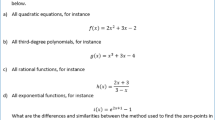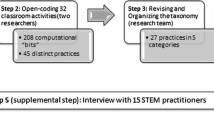Abstract
The Physical Chemistry in Practice (PCIP) DVD contains video programs (modules) and experimental data that present the research of scientists working in applications of physical chemistry. The DVD allows students to learn about cutting edge research in physical chemistry while making connections to the theoretical concepts learned in lecture. PCIP-DVD allows students to build verbal and pictorial models of the experiments, instrumentation, and data that can be integrated with the material covered in lecture. For each of the modules implemented students were tested in a pre/post test fashion over content related objectives. For every module the students demonstrated a statistically significant improvement in their understanding.







Similar content being viewed by others
References
Abraham M, Grybowski E, Renner J, Marek E (1992) Understandings and misunderstandings of eight graders of five chemistry concepts found in textbooks. J Res Sci Teaching 29:105–120
Abraham MR, Williamson VM, Westbrook SL (1994) A cross-age study of the understanding of five chemistry concepts. J Res Sci Teaching 31:147–165
Berrie CL, Leone SR (2002) Desorption of arsenics species during the surfactant enhanced growth of Ge on Si(100). J Phys Chem B 106:6488–6493
Clark JM, Paivio A (1991) Dual coding theory and educational instruction. Educ Psychol Rev 3:149–210
Coté GL, O’Neal P, Motamedi M, Lin WC, Chen J (1998) Surface enhanced Raman spectroscopy for the detection amino acids following head injury. Presentation at the 16th Annual Houston Conference on Biomedical Engineering Research, University of Houston, Houston, TX
Hinsberg WD, Houle FA, Sanchez MI, Wallraff GM (2001) Chemical and physical aspects of the post-exposure baking process used for positive-tone chemically amplified resists. IBM J Res Dev: Adv Semiconductor Lithogr 45(5):667–683
Knier G (2007) How do photovoltaics work? http://science.nasa.gov/headlines/y2002/solarcells.htm, accessed 2/2007
Liu B, Berrie CL, Kitajima T, Bright J, Leone SR (2002a) Atomic force microscopy study of the growth and annealing of Ge islands on Si(100). J Vacuum Sci Technol B 20:678–684
Liu B, Berrie CL, Kitajima T, Leone SR (2002b) Arsenic-induced Ge island morphology changes during molecular beam epitaxy of Ge on Si(100). J Cryst Growth 241:271–276
Mayer RE (1997) Multimedia learning: are we asking the right questions? Educ Psychol 32:1–19
Mayer RE (2001) Multimedia learning. Cambridge University Press, Cambridge, UK
Mayer RE (2002) Cognitive theory and the design of multimedia instruction: an example of the two-way street between cognition and instruction. New Directions Teaching Learning 89:55–71
O’Neal P, Coté GL, Motamedi M, Chen J, Lin WC (2003) Feasibility study using surface-enhanced Raman spectroscopy for the quantitative detection of excitatory amino acids. J Biomed Opt 8(1):33–39
Paivio M (1986) Mental Representations: a dual coding approach. Oxford University Press, Oxford, England
Schwenz RW, Moore RJ (1993) Physical chemistry: developing a dynamic curriculum. American Chemical Society, Washington, DC
Seymour E (1997) Student assessment of learning gains. Available at hhttp://www.wcer.wisc.edu/salgains/instructor/default.asp (Accessed 2/2007)
Seymour E, Wiese DJ, Differed S, Hunter, A (2000) Creating a better mousetrap: on-line student assessment of their learning gains. Paper presented at the National American Chemical Society San Francisco, CA
Zielinski TJ, Schwenz RW (2004) Physical chemistry: a curriculum for 2004 and beyond. Chem Educ 9:108–121
Acknowledgements
This material is based upon work supported by the National Science Foundation under Grant Nos. 0127541 and 9980862. The PCIP-DVD may be obtained from Dr. Gabriela Weaver at the email address given at the beginning of this article. The researchers would also like to thank Dr. Richard Schwenz and Dr. Larry Anderson for their assistance in data collection associated with this research.
Author information
Authors and Affiliations
Corresponding authors
Rights and permissions
About this article
Cite this article
Dyer, J.U., Towns, M. & Weaver, G.C. Physical Chemistry in Practice: Evaluation of DVD Modules. J Sci Educ Technol 16, 431–442 (2007). https://doi.org/10.1007/s10956-007-9066-2
Published:
Issue Date:
DOI: https://doi.org/10.1007/s10956-007-9066-2




